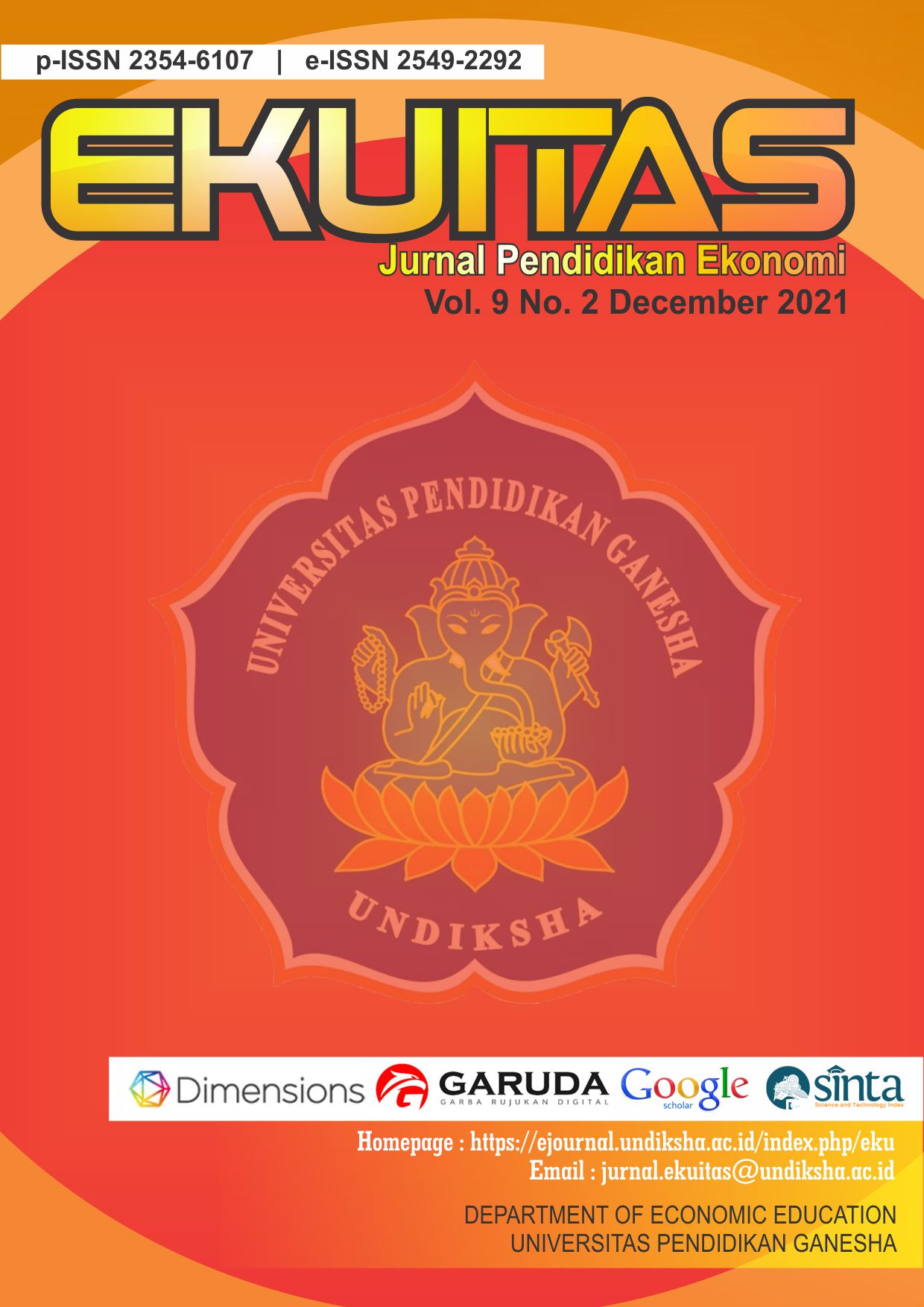The Millennial’s Investment Decisions: Implications of Financial Literacy, Motivation, and Digitalization
DOI:
https://doi.org/10.23887/ekuitas.v9i2.39328Keywords:
digitalization, financial literacy, investment decision, motivationAbstract
Investment as a means of developing assets is no longer a luxury activity reserved for a select few. Nowadays, as financial technology advances, everyone has equal access to investment information. This change generates new perspectives in which investing is not restricted to the wealthy, leading everyone, even on-budget millennials to be investors. The purpose of this research is to determine the variables affecting investing decisions at an early age, especially among millennials. This research adopted single-equation regression models to examine the dependent variable on several explanatory variables and estimate mean or average value. The data was generated using a questionnaire to 140 respondents. Three distinct variables utilized as independent variables are financial literacy, motivation, and the digitization of investing platforms. The findings indicate that financial literacy and motivation substantially affect millennials’ investment decisions, while digitization presents no correlation to the Millennials’ investment decisions.
References
Arianti, B. F. (2018). The influence of financial literacy, financial behavior and income on investment decision. EAJ (Economic and Accounting Journal), 1(1), 1–10.
Avram, E. L., Savu, L., Avram, C., IGNAT, A. B., Vancea, S., & Horja, M. I. (2009). Investment decision and its appraisal. Annals of DAAAM & Proceedings.
Azizah, N. S. (2020). Pengaruh literasi keuangan, gaya hidup pada perilaku keuangan pada generasi milenial. Prisma (Platform Riset Mahasiswa Akuntansi), 1(2), 92–101.
Barber, B. M., & Odean, T. (2001a). Boys will be boys: Gender, overconfidence, and common stock investment. The Quarterly Journal of Economics, 116(1), 261–292.
Barber, B. M., & Odean, T. (2001b). The internet and the investor. Journal of Economic Perspectives, 15(1), 41–54.
Bebasari, N., & Istikomah, A. (2020). The effect of investment motivation, financial literation, and financial behavior on investment decisions (Studies on Management Students at Pelita Bangsa University). Journal of Research in Business, Economics, and Education, 2(4), 842–851. https://ojk.go.id
Bollaert, H., Lopez-de-Silanes, F., & Schwienbacher, A. (2021). Fintech and access to finance. Journal of Corporate Finance, 68, 101941. https://doi.org/10.1016/j.jcorpfin.2021.101941
Christanti, N., & Mahastanti, L. A. (2011). Factors considered by investors in investing. Journal of Theory and Applied Management, 4(3), 37–51.
Daskalakis, N., & Yue, W. (2017). User’s Perceptions of Motivations and Risks in Crowdfunding with Financial Returns. SSRN Electronic Journal. https://doi.org/10.2139/ssrn.2968912
Databoks. (2021). Jumlah pengunjung tokopedia kalahkan shopee pada kuartal I-2021. https://databoks.katadata.co.id/datapublish/2021/06/11/jumlah-pengunjung-tokopedia-kalahkan-shopee-pada-kuartal-i-2021
Fedorova, E. A., Nekhaenko, V., & Dovzhenko, S. E. (2015). Impact of financial literacy of the population of the Russian federation on behavior on financial market. Empirical Evaluation. Russian Economic Develompment, 26(4), 394–402.
Grohmann, A., Klühs, T., & Menkhoff, L. (2018). Does financial literacy improve financial inclusion? Cross country evidence. World Development, 111, 84–96. https://doi.org/10.1016/J.WORLDDEV.2018.06.020
Gujarati, D. N. (2004). Basic econometrics. The Mc-Graw Hill.
Han, B., & Hirshleifer, D. A. (2016). Social transmission bias and active investing. HKUST Finance Symposium.
Harcourt. (1967). Economic Activity (Re-issued). Cambridge University Press, New York.
Huston, S. J. (2010). Measuring financial literacy. Journal of Consumer Affairs, 44(2), 296–316.
Jones, C. S., & Tuzel, S. (2013). Inventory investment and the cost of capital. Journal of Financial Economics, 107(3), 557–579.
Lee, C. C., Li, X., Yu, C. H., & Zhao, J. (2021). Does fintech innovation improve bank efficiency? Evidence from China’s banking industry. International Review of Economics and Finance, 74, 468–483. https://doi.org/10.1016/j.iref.2021.03.009
Manurung, A. . (2012). Teori Investasi: Konsep Dan Empiris. PT Adler Manurung Press.
Markowitz, H. (1952). The utility of wealth. Journal of Political Economy, 60(2), 151–158.
Mirsch, T., Lehrer, C., & Jung, R. (2017). Digital nudging: Altering user behavior in digital environments. Proceedings Der 13. Internationalen Tagung Wirtschaftsinformatik (WI 2017), 634–648.
Nisa, A. (2017). Pengaruh pemahaman investasi, modal minimal investasi dan motivasi terhadap minat mahasiswa berinvestasi di pasar modal (Studi pada Mahasiswa Sekolah Tinggi Kesuma Negara). Jurnal Penelitian Teori & Terapan Akuntansi (PETA), 2(2), 22–35.
Nofsinger, J. R. (2002). Investment Blunders of the rich and famous-and what you can learn from them. FT Press.
OJK. (2013). National Strategy of Financial Literacy of Indonesia.
OJK. (2020). Survei Nasional Literasi dan Inklusi Keuangan 2019. https://www.ojk.go.id/id/berita-dan-kegiatan/publikasi/Pages/Survei-Nasional-Literasi-dan-Inklusi-Keuangan-2019.aspx
OJK. (2021). Statistik fintech lending periode Mei 2021. https://www.ojk.go.id/id/kanal/iknb/data-dan-statistik/fintech/Pages/Statistik-Fintech-Lending-Periode-Mei-2021.aspx
Robb, C. A., & Woodyard, A. S. (2011). Financial knowledge and best practice behavior. Journal of Financial Counseling and Planning, 22(1), 60–70.
Rosdiana, R. (2020). Analysis of Investment interests, motivation, social environment, financial literacy (Comparative study of generation Z and millennial generation). International Journal of Business, Economics and Law, 22(1), 111–121.
Snow, N. M., & Rasso, J. (2017). If the tweet fits: How investors process financial information received via social media.
Solanki, S, Wadhwa, S, Gupta, S. (2019). Digital technology: An influential factor in investment decision making. International Journal of Engineering and Advanced Technology, 8(6S4), 27–31. https://doi.org/10.35940/ijeat.f1007.1186s419
Sujianto, A. E. (2009). Aplikasi statistik dengan SPSS 16.0. Jakarta: Prestasi Pustaka, 97.
Tarora, H., & Juwita, R. (2017). Analisis Pengaruh Literasi Keuangan Terhadap Keputusan Investasi (Studi Kasus Nasabah Asuransi Generali Indonesia Cabang Palembang).
Virlics, A. (2013). Investment decision making and risk. Procedia Economics and Finance, 6, 169–177. https://doi.org/10.1016/s2212-5671(13)00129-9
Walia, N., & Kumar, R. (2007). Online stock trading in India: An empirical investigation. Indian Journal of Marketing, 37(4).
William, F. (2005). Investasi (1st ed.). PT. Indeks Kelompok Gramedia.
Yang, W., Lin, D., & Yi, Z. (2017). Impacts of the mass media effect on investor sentiment. Finance Research Letters, 22, 1–4.
Zalviwan, M., Haryono, T., & Sawitri, H. S. R. (2020). Investors psychology on the biased investment decision: The mediating effect of extra-motivation to invest. Jurnal Keuangan Dan Perbankan, 24(4), 506–519.








